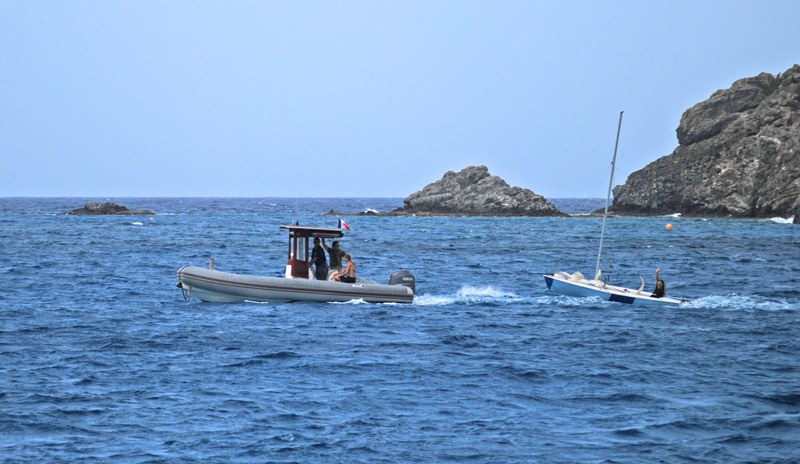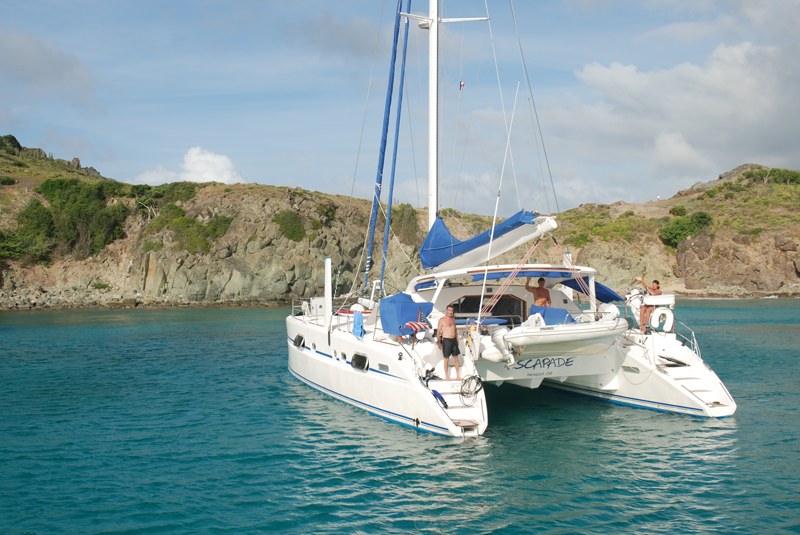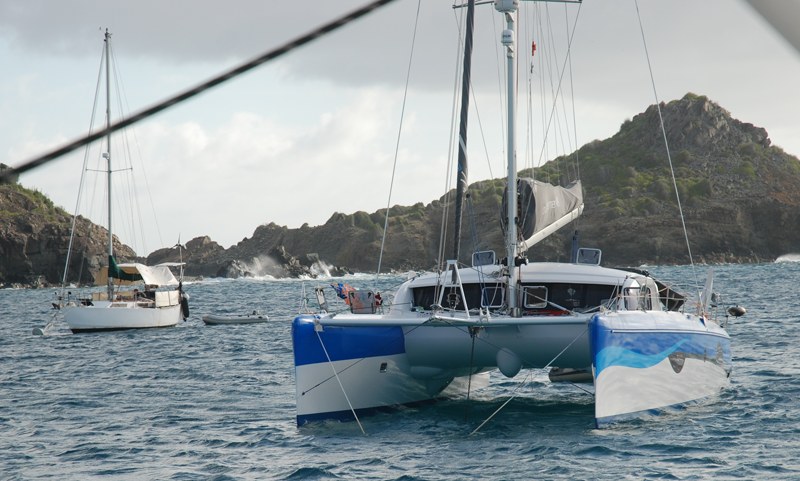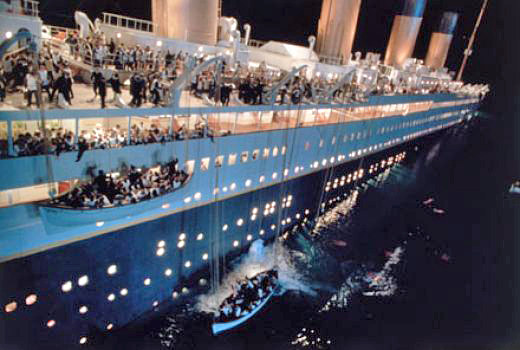
Saved by a Decibel or Two

© Latitude 38 Media, LLC
It was the stressed tone of the voice that attracted our attention. We were sitting on the back of ‘ti Profligate, anchored just outside the #2 marker for the entrance to the port of Gustavia at the tiny island of St. Barth in the French West Indies, when we thought we heard a strange call. We looked around at the 50 or so boats to the shoreward side of us, and couldn’t see anything. So we went back to work on a teak step for the boarding ladder. It seemed like we heard a distressed call once again. So again we looked toward the boats, all of which were inside of us, and toward shore. But it was hard to tell if someone was calling because it was blowing in excess of 15 knots. And there was also the hole in our left eardrum courtesy of surfing.
When there was yet another call, we looked out to sea in the direction of Pan du Sucre, a very small and isolated island about a half mile offshore to leeward. We could just make out what looked like the blue hull of a flipped dinghy, a dinghy we remember sailing around us about 20 minutes before. There was obviously trouble. We called for Doña to grab the handheld, then both of us jumped into the dinghy and took off in the direction of the flipped boat about a half-mile away.
After going about 100 yards in the sloppy conditions, Doña asked, "Where are you going?" About to ask her what she meant, we looked about 100 yards to port and saw a woman waving her arms for help as chop repeatedly washed over her head. Suddenly we realized that it was she who had been yelling, as the boat was too far away.
Thanks to the 84° water, and the fact the woman hadn’t been in the water more than 10 minutes, she was still in good shape and we were able to easily pull her aboard. But boy, was she glad to see us — she didn’t have a PFD, and she’d been rapidly drifting toward 30-mile distant Saba. We were her last good chance of being seen or heard on the big ocean.
She told us she’d fallen off the blue sailboat, now hundreds of yards away, that she’d been sailing on with her girlfriend. We sped off in the direction of the flipped boat, and found the second woman, who also wasn’t wearing a PFD, clinging to her small, upended dinghy. It was really lucky we saw her because, if Birdy wasn’t about to have a dive charter at Pan du Sucre, she would have drifted to oblivion. But again thanks to the warm water, she was still in fine shape — although she’d been worried.
She explained that she was just learning to sail her boat, and it had flipped. She didn’t have a good explanation about why she didn’t have a PFD.
We think the biggest lesson to be taken from the experience is that, when learning to sail in small boats, take lessons and learn in a supervised environment. The last thing you want is to find yourself in distress while rapidly drifting to leeward without any way to signal for help.

©2010 Latitude 38 Media, LLC
In other news from St. Barth, it was just last Thursday night that Greg Dorland and Debbie Macrorie of the Tahoe-based Catana 52 Escapade couldn’t decide whether they, with Michael Kennedy and Alan Weaver as crew, would leave the next morning for Trinidad or for Bermuda and the Northeast. The decided on Bermuda, and in the short run regretted it. A very unusual low for this time of year stuck with them for most of the trip and, as a result, they had winds to 45 knots and twice had to douse the main. On the other hand, they did complete the nearly 900-mile passage in just under four days, and hit a top speed of 22 knots.

©2010 Latitude 38 Media, LLC
Follow-Up on Sunday’s Tragedies
As we reported in an update on Monday’s story about the loss of three sailors on Sunday, the couple who fell off the Ranger 33 Barcarolle near Ocean Beach were Jeff and Beth Easterling of El Sobrante. A few more details have come out since the initial report, most notably that Jeff Easterling had owned Barcarolle for 25 years and that they both appeared to be wearing PFDs at the time of the accident. Jeff was found wearing his when his body washed ashore Monday morning on Ocean Beach, and a PFD was found near Beth when she was recovered. It’s unknown if it was washed off her or if she was holding it. Barcarolle has since been salvaged from China Beach and is now sitting in an area boatyard. She’s missing her mast, keel and rudder, and most of the starboard ports have been blown out. We can’t believe she’s anything but a total loss.
Sadly, the search for Tom Kirschbaum of the Marina del Rey-based International Folkboat Feral was terminated Monday afternoon with no sign of Tom. Having known him to be one of the most safety conscious sailors we’ve ever met, his loss has come as a shock. In fact, we can’t believe he was out that day without wearing his PFD and harness, as we never knew him to go without them, regardless of conditions. If that was the case — and we will never know with any certainty — it’s a sobering reminder that all safety gear has its limits.
UPDATE: Tom Kirschbaum’s body was found off Long Beach today. Reports are that he was wearing his PFD and harness. The coroner will be performing an autopsy.
Hot Latitude Gear
There’s no better way to stand out in a crowd than by wearing a Latitude 38 T-shirt or hat, available in an array of fruity colors. Choose your favorite color in our online chandlery.
It’s Every Man for Himself
Last month marked the 98th anniversary of the sinking of the Titanic. Not to take anything away from the horror of that night, but come on — hasn’t the whole Titanic thing been pretty well beaten to death? Could there possibly be a single aspect of this story that hasn’t been dissected in minutiae, or a single new thing to be learned? Well, according to a recent study by the Queensland (Australia) University of Technology, the answer is yes.
There is a long-standing economic theory that people generally behave in a rational and selfish manner. This is one of those concepts that’s really hard to test, much less prove, so scientists will often look back at real events in history to see if they are relevant. Turns out the Titanic sinking was a perfect petri dish. As counterpoint, the scientists also looked closely at the sinking of another famous liner, the Lusitania, which was torpedoed and sunk off Ireland just three years later.
The ships were of similar size, and had a similar complement of crew and passengers — many rich, many poor, many women and children. The differences in their ends were that the Titanic took about three hours to sink, while the Lusitania went down in 18 minutes. And true to the scientists’ suppositions, the scenarios aboard each ship were markedly different: aboard Titanic, where the ‘grace period’ allowed social mores to kick in, men forwent their own safety to fill most of the lifeboats with the women and children — and in the overall demographic, a much higher percentage of women and children survived that sinking than men. On Lusitania, ‘rational and selfish’ kicked in immediately, and the main survival group consisted of men — either the strongest young men of any social standing, or older men who bribed their way onto the boats.

The whole study appeared in the Proceedings of the National Academy of Science earlier this year, and the scientific community will doubtless be buzzing for years to come about what it meant. The moral of the story for the rest of us: Hope you’re never aboard a luxury liner that sinks, because whatever happens, it ain’t gonna be pretty.
Ocean Racing Entry Deadlines
Thanks to everyone who took the time to send us their feedback on ocean racing entry deadlines. It was too late to get them in the June issue and we simply didn’t have room for all the responses here. However, we’d like to share some excerpts:
Daniel Willey of the Nauticat 43.5 Galaxsea: "In a singlehanded race, 10 days is not that bad. In a crewed race, crew selection is always an issue — best to wait and get it right."
SSS and St. Francis YC member George Mann of the C&C 35 Robin: "If you are not prepared for all kinds of weather, you should probably not be signing up for an ocean race. A simple case in point was the recent OYRA Duxship. The weather report the night before was for 6-11 knots building to 14 further north near Duxbury. As it turned out the wind was in the mid-twenties and there were very steep and confused seas."
Mike Fitzmorris: "I think the real question is what does the Coast Guard do with the entry list? Is there any possible value in a list of boat names being handed in before a search is begun? As long as the right people have the necessary information ahead of the race, what benefit is there in the list sitting around the Coasties’ office? Do they study the entry form and give the patrols a pop quiz on the boats entered?"
Sue Burns, from the Corinthian YC of Portland, and PRO for next year’s Oregon Offshore — a 1.5- to 3-day race from Astoria, Oregon to Victoria, BC — shared that club’s experiences with the permitting process for what’s also a potentially dangerous stretch of racetrack: "Our race entry deadline is always approximately 2.5 weeks before the start of the race to coincide with our kick-off party. This gives everyone, including the race committee and the racing boats and crews the time to make sure that everything is in order . . . Our Coast Guard permit requires review by multiple Coast Guard districts as well as Seattle Vessel Traffic before it is issued. We have not been asked for a list of racing boats at the time we apply for the permit, or before it is granted. We do have to give Seattle VTS a list of the racing boats, but that list is not faxed to them until after the boats have started . . . There is no reason for them to have the list ahead of time since some boats might not start. . . . Despite no requirement for a list of entrants before the race permit is granted, we still have the panic-inducing problem of not getting our permit until shortly — this time it was a couple of days — before the race."
Steve Wonner, owner Wyliecat 30 Uno: "I think it’s reasonable to require sign ups 10 days in advance for ocean races. There are lots of additional requirements for ocean equipment and new administrative hoops to jump through. I appreciate the intent of the Coast Guard to protect us from ourselves, but resist the added intrusion. I’ve had numerous encounters with the CG, and though well-meaning, most have little or no sailing experience and don’t really know what’s safe and what’s not. That evaluation should rest with the individual or, at worst, the Race Committee. That said, it looks like we’re stuck with a 10-day advance sign up. Get used to it."
Jeff Dunnavant, SSS member, of the Baltic 42 DP True North: "If the Coast Guard is giving permission to sail or not, and taking some of the responsibility away from the sailor, does this mean they take responsibility when they do allow a race? What if the race would continue without a Coast Guard Permit for the race? Other than reprimanding the organizing club, what authority do they have?"
Jeff poses a couple of good questions. Apparently, the insurance companies don’t seem to be too concerned about the permits. But, while a lot of the respondents dislike the encroachment the new permit process represents, no one feels it’s in any racer’s interest to thumb our noses at the agency our tax dollars pay for to come rescue our butts after we’ve exhausted every other possibility and done everything we can to prevent them from having to do that. Still, among many of the respondents, there was a rational fear that the new permitting requirements might lead to further restrictions on ocean racing down the line. The first brick in the wall, so to speak.
In the meantime, given that the permitting process is new this year, and that all the ocean-race-running clubs are responding — quite well — to it, we think there are definitely ways to streamline the entire process to cause as little disruption to sailors as possible. One respondent rightly pointed out that R/Cs having to issue refunds would be a tremendous burden on already overworked volunteers. But given that almost every yacht club now uses a capable on-line event management software, we think there has to be a way to streamline the entire process in such a way that satisfies all the interested parties.
